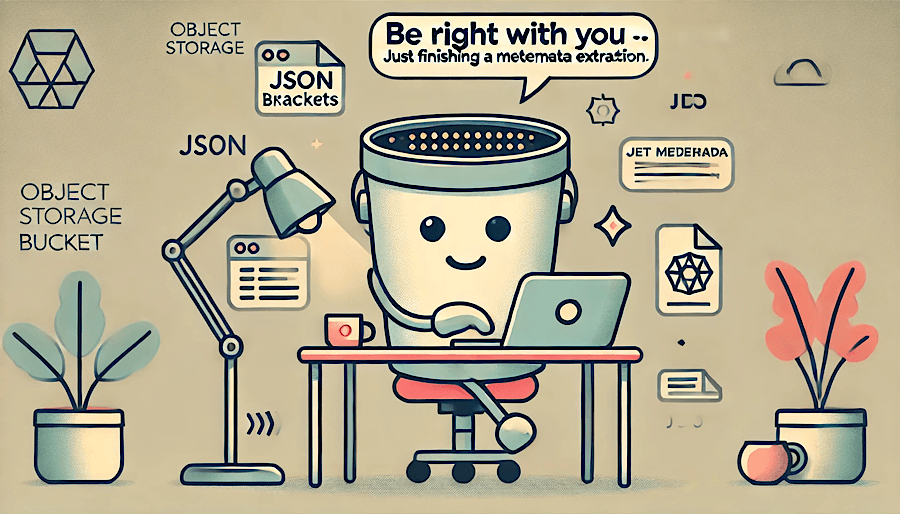What If Your Storage Knew How to Talk Back?

Storage isn’t silent anymore. We might be entering a ‘put and prompt’ world — where even your bucket has something to say. Illustrated by DALL·E
We talk to APIs. We query databases. We prompt models. But storage? Storage has mostly stayed in the background.
Until now.
At Cloud Field Day 23, MinIO offered a different take. With the introduction of PromptObject and the Model Context Protocol (MCP), they proposed a world where object storage isn’t just where data rests—it’s where intelligent interaction begins. It raised a compelling question: could inference start at the bucket, rather than after it?
From REST to Response: Storage Joins the Application Stack
PromptObject allows developers to interact with unstructured data—PDFs, images, videos—using natural language prompts. Structured JSON responses can be retrieved from raw content without manual parsing or a vector database. As MinIO engineer Dil Radhakrishnan put it:
“We’re moving from a ‘put and get’ world to a ‘put and prompt’ world.”
This subtle change suggests a deeper shift. PromptObject blurs the line between storage and application, allowing the object store to participate in the reasoning process. It’s a design that reframes object storage as more than just a backend—it becomes part of the interface.
🛠️ Architectural View
PromptObject sits on top of MinIO’s object-native architecture—flat namespace, no metadata database, and deterministic hashing. By integrating with LLM APIs such as OpenAI or NVIDIA NIM, the system converts objects into prompt-friendly formats and returns structured outputs. All of this happens within the storage plane.
Why Talk to Your Database When You Could Talk to Your Bucket?
For developers accustomed to spinning up extractors and parsers, the simplicity of PromptObject may feel like a shortcut. You can point to an object and ask for a summary, metadata, or transformation—without loading or parsing it into an application layer.
“Talk to unstructured objects as if they were an LLM.”
Whether this replaces vector DBs or complements them remains to be seen, but it certainly challenges assumptions about where inference belongs in the stack.
🛠️ Architectural View
PromptObject uses function chaining to interact with multiple objects concurrently. It integrates seamlessly with MinIO’s S3-compatible API, returning structured data in a developer-friendly format. Schema enforcement via Pydantic ensures outputs can be ingested directly into downstream systems.
MCP: Storage with a Function Call Interface
The Model Context Protocol (MCP), introduced by Anthropic and adopted by MinIO, standardizes the way external tools—or agents—call storage functions. These include listing buckets, tagging files, or even generating dashboards.
“Think of MCP like a USB-C port for AI applications.” Some in the community have already begun drawing parallels: MCP, they suggest, could do for AI agents what REST did for web services.
This approach positions storage as a service endpoint—not just an API to retrieve bits from, but a surface that can be queried and composed. It offers a more secure, scoped interface for automation, particularly in multi-user environments.
🛠️ Architectural View
MinIO’s MCP implementation exposes storage functions over TLS, with default read-only permissions. Commands can be issued from LLMs or orchestration layers to query, tag, or retrieve structured data. This adds a layer of programmability to storage without compromising performance or security.
A New Surface for Interaction?
It’s tempting to think of this as a novelty. But in a world where AI models increasingly rely on structured context and fast retrieval, letting storage speak may be more than clever—it may be necessary.
As MinIO demonstrated, the object store isn’t just a passive repository. It can be the first place insight forms. Whether PromptObject and MCP become standard tools remains to be seen, but the idea that storage might one day respond to a prompt is no longer science fiction—it’s a CLI call away.
The model gets a prompt. The object deserves one too. And maybe, so do we — a prompt to rethink what storage is really for.
🔍 Links for Further Reference
Watch the full Cloud Field Day 23 sessions:






